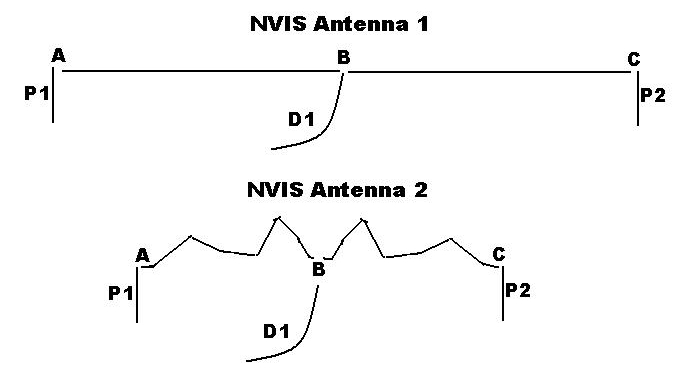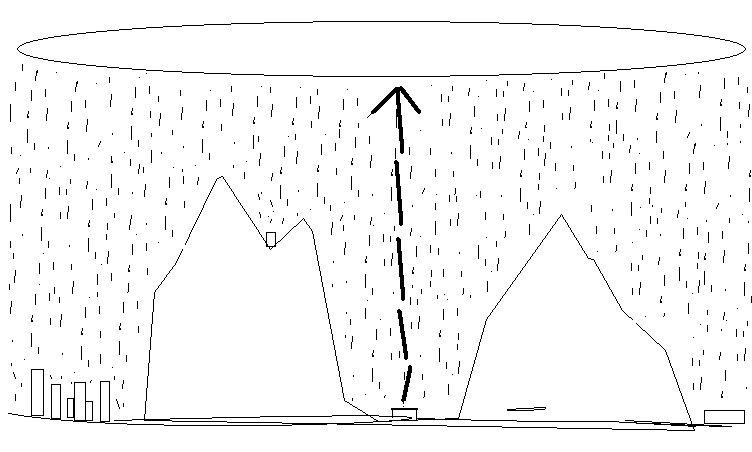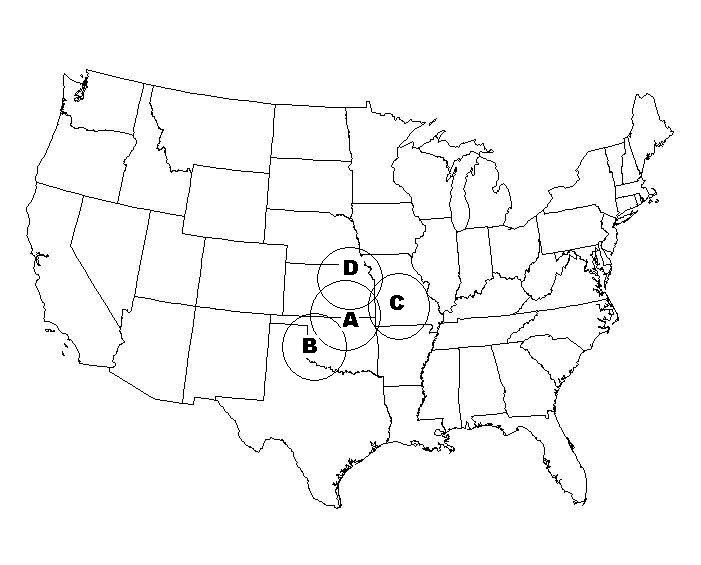|
Technical Aspects of the Antenna Key to the S.A.F.E. EMS is the type of antenna that is used. Not that the radio won't work with many different kinds of antennas, because it will. The thing is that the type of antenna determines the coverage that the radio will give. If one uses it with many/most types of Ham antennas then they may get great random long distance coverage. That was fine for Ham hobbyists, but is not the purpose of the S.A.F.E. EMS. What we are wishing to obtain is RELIABLE area coverage/communication out to three or four hundred miles. For a cost of about $10, and a couple of hours time, you can install an antenna that will work, but we plan to include one that is all cut and ready to go. Here are the principles on how to build one. The details are in our manual, which you can download for free. The antenna itself is VERY simple. Since we are dealing with a dipole for the 80m band, one half the wave length is 40 meters. Forty meters converts to (is the same as) 131 feet which means that by this method the two wires need to EACH be 65 and a half feet long. Below is a simple sketch. 
1. Poles P1 and P2 extend 12 feet above the ground. The height should be that, within about a foot. That is also a nice height which most cars and small trucks will go beneath without knocking it down, and you won't walk into it - in the middle of the night. 2. The two 65 and a half foot dipole wires, from A to B, and from B to C, can be any wire (covered or uncovered). Copper is always nice. 3. A, B, and C, are isolators which you can make out of plastic pop bottles. 4. D1 is the drop line which can be quite long. It is just an old flat TV antenna wire, which you run off to your radio. --------- The NVIS 2 drawing shows that the antenna can run crookeder than a dogs hind leg. Far more such than I show. The wires between A and B, and between B and C, still have to be the same length but where they twist and turn you have to hang them onto a tree or something to hold them up. This is all neat because the antenna rolls up into a nice package - say around our shipping can - and you can just go out in the woods and hang it up in the trees. Many Ham antennas work on a 'skip' principle. They are designed so that the signal bounces off a stratospheric layer and skips on an angle back to the earth then back up at an angle again to the stratosphere and back at an angle again down to the ground, sometimes as many as five times around the curvature of the earth to some great distance that may be ten thousand miles. The S.A.F.E antenna works differently. The S.A.F.E. EMS NVIS (Near Vertical Incidence Skywave) antenna works best during the nighttime to provide a reliable straight up and down signal to the ionosphere to reflect a signal within a circle of a diameter of perhaps six hundred miles. Usually much less in the daytime. 
The Cloud Burner
Because to any radio range finder the signal is coming straight down from the sky, the location of the transmitter is hidden. This is especially true if it is in a low valley or even down in a sand pit. One of the conventional wisdoms among ham radio preppers has been - "Listen but don't reply." That is really useless for developing communication and cooperative resources. With this system one need not be concerned about there location being randomly disclosed to radio range finder. Coverage 
Coverage
With a different antenna location, our radio at location A might even reach to Europe. But not reliably. The SAFE EMS is designed for reliable communication. Very few systems communicate reliably the distances that our radio is designed for. I have spent many, many hours, actually many days studying the NVIS antenna and there is lots of conflicting opinion out there. In addition there are a great many affecting variables such as surrounding terrain, nearness of conducting structures, the type of soil beneath the antenna, and the list goes on. Generally not to worry about it. You are going to do what you have to do - where you have to do it. And when you have to do it. There is no way to predict what we call propagation conditions will be, when you need it. Signal propagation is affected by many things. Daytime and night time, as we have discussed, but also the time of the year, the latitude at which you are located, the season, sunspot cycles, the weather and, and, and the list just goes on and on. If you look up the article on "ionosphere" in Wikipedia and also the article on "80-meter band" you will wonder how in the world any of it ever works and why we picked what we did. I can assure you that it was after very careful consideration and after considering many, many variables. 80 meter is the longest of the High Frequency waves, and while this means that it requires a long antenna it also means that its wave is more easily captured. Our PSK31 transmitting and receiving method is digital, which greatly increases accuracy and it is extremely slow among digital signals which also greatly enhances its reliability. Over such things as distance, speed, convenience of sending pictures and charts, we have always chosen reliability. This has been the leading factor, along with cost, in the design of the radio itself. There are many factors which, while we can guess at them, we can't reliably predict them. No one really knows what will happen to the various levels of the atmosphere and the ionosphere itself after a nuclear WW3. Great amounts of cloud cover at particular levels may greatly affect ionization. Things are afoot in the Cosmos - and we don't know what sun cycles or sun effects may cause at the time. It is a long and speculative list. Once again our response was to seek for reliability under the various speculated situations. Some may say, with considerable justification, that the most reliable method to go with would be CW (Continuous Wave used with Morse Code), but the practicality of the prepper situation is that few would learn it. |